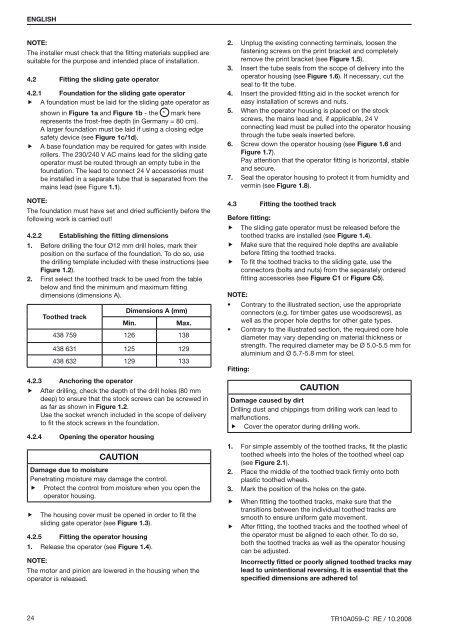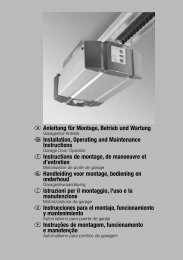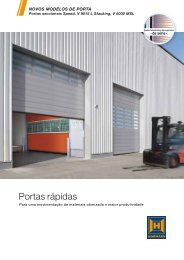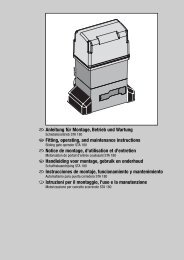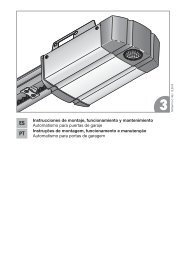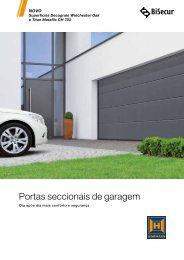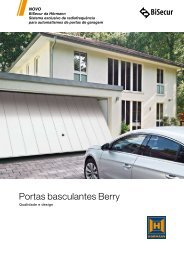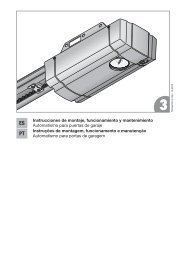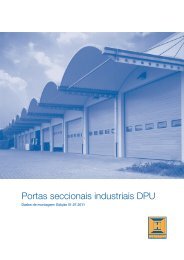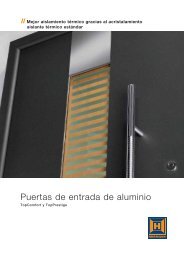Automatismo para puerta corredera LineaMatic - Hörmann
Automatismo para puerta corredera LineaMatic - Hörmann
Automatismo para puerta corredera LineaMatic - Hörmann
Create successful ePaper yourself
Turn your PDF publications into a flip-book with our unique Google optimized e-Paper software.
ENGLISH<br />
Note:<br />
The installer must check that the fitting materials supplied are<br />
suitable for the purpose and intended place of installation.<br />
4.2<br />
Fitting the sliding gate operator<br />
4.2.1 Foundation for the sliding gate operator<br />
ff A foundation must be laid for the sliding gate operator as<br />
shown in Figure 1a and Figure 1b - the * mark here<br />
represents the frost-free depth (in Germany = 80 cm).<br />
A larger foundation must be laid if using a closing edge<br />
safety device (see Figure 1c/1d).<br />
ff A base foundation may be required for gates with inside<br />
rollers. The 230/240 V AC mains lead for the sliding gate<br />
operator must be routed through an empty tube in the<br />
foundation. The lead to connect 24 V accessories must<br />
be installed in a se<strong>para</strong>te tube that is se<strong>para</strong>ted from the<br />
mains lead (see Figure 1.1).<br />
Note:<br />
The foundation must have set and dried sufficiently before the<br />
following work is carried out!<br />
4.2.2 Establishing the fitting dimensions<br />
1. Before drilling the four Ø12 mm drill holes, mark their<br />
position on the surface of the foundation. To do so, use<br />
the drilling template included with these instructions (see<br />
Figure 1.2).<br />
2. First select the toothed track to be used from the table<br />
below and find the minimum and maximum fitting<br />
dimensions (dimensions A).<br />
4.2.3<br />
Toothed track<br />
Dimensions A (mm)<br />
Min.<br />
Max.<br />
438 759 126 138<br />
438 631 125 129<br />
438 632 129 133<br />
Anchoring the operator<br />
ff After drilling, check the depth of the drill holes (80 mm<br />
deep) to ensure that the stock screws can be screwed in<br />
as far as shown in Figure 1.2.<br />
Use the socket wrench included in the scope of delivery<br />
to fit the stock screws in the foundation.<br />
4.2.4<br />
Opening the operator housing<br />
CAUTION<br />
Damage due to moisture<br />
Penetrating moisture may damage the control.<br />
ff Protect the control from moisture when you open the<br />
operator housing.<br />
ff The housing cover must be opened in order to fit the<br />
sliding gate operator (see Figure 1.3).<br />
4.2.5 Fitting the operator housing<br />
1. Release the operator (see Figure 1.4).<br />
Note:<br />
The motor and pinion are lowered in the housing when the<br />
operator is released.<br />
2. Unplug the existing connecting terminals, loosen the<br />
fastening screws on the print bracket and completely<br />
remove the print bracket (see Figure 1.5).<br />
3. Insert the tube seals from the scope of delivery into the<br />
operator housing (see Figure 1.6). If necessary, cut the<br />
seal to fit the tube.<br />
4. Insert the provided fitting aid in the socket wrench for<br />
easy installation of screws and nuts.<br />
5. When the operator housing is placed on the stock<br />
screws, the mains lead and, if applicable, 24 V<br />
connecting lead must be pulled into the operator housing<br />
through the tube seals inserted before.<br />
6. Screw down the operator housing (see Figure 1.6 and<br />
Figure 1.7).<br />
Pay attention that the operator fitting is horizontal, stable<br />
and secure.<br />
7. Seal the operator housing to protect it from humidity and<br />
vermin (see Figure 1.8).<br />
4.3<br />
Fitting the toothed track<br />
Before fitting:<br />
ff The sliding gate operator must be released before the<br />
toothed tracks are installed (see Figure 1.4).<br />
ff Make sure that the required hole depths are available<br />
before fitting the toothed tracks.<br />
ff To fit the toothed tracks to the sliding gate, use the<br />
connectors (bolts and nuts) from the se<strong>para</strong>tely ordered<br />
fitting accessories (see Figure C1 or Figure C5).<br />
Note:<br />
• Contrary to the illustrated section, use the appropriate<br />
connectors (e.g. for timber gates use woodscrews), as<br />
well as the proper hole depths for other gate types.<br />
• Contrary to the illustrated section, the required core hole<br />
diameter may vary depending on material thickness or<br />
strength. The required diameter may be Ø 5.0-5.5 mm for<br />
aluminium and Ø 5.7-5.8 mm for steel.<br />
Fitting:<br />
CAUTION<br />
Damage caused by dirt<br />
Drilling dust and chippings from drilling work can lead to<br />
malfunctions.<br />
ff Cover the operator during drilling work.<br />
1. For simple assembly of the toothed tracks, fit the plastic<br />
toothed wheels into the holes of the toothed wheel cap<br />
(see Figure 2.1).<br />
2. Place the middle of the toothed track firmly onto both<br />
plastic toothed wheels.<br />
3. Mark the position of the holes on the gate.<br />
ff When fitting the toothed tracks, make sure that the<br />
transitions between the individual toothed tracks are<br />
smooth to ensure uniform gate movement.<br />
ff After fitting, the toothed tracks and the toothed wheel of<br />
the operator must be aligned to each other. To do so,<br />
both the toothed tracks as well as the operator housing<br />
can be adjusted.<br />
Incorrectly fitted or poorly aligned toothed tracks may<br />
lead to unintentional reversing. It is essential that the<br />
specified dimensions are adhered to!<br />
24 TR10A059-C RE / 10.2008


